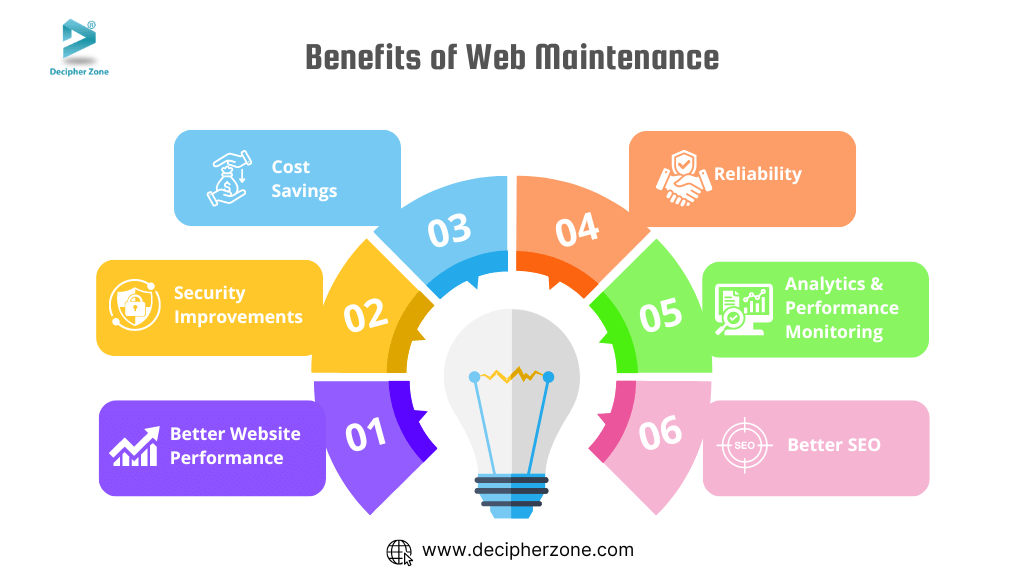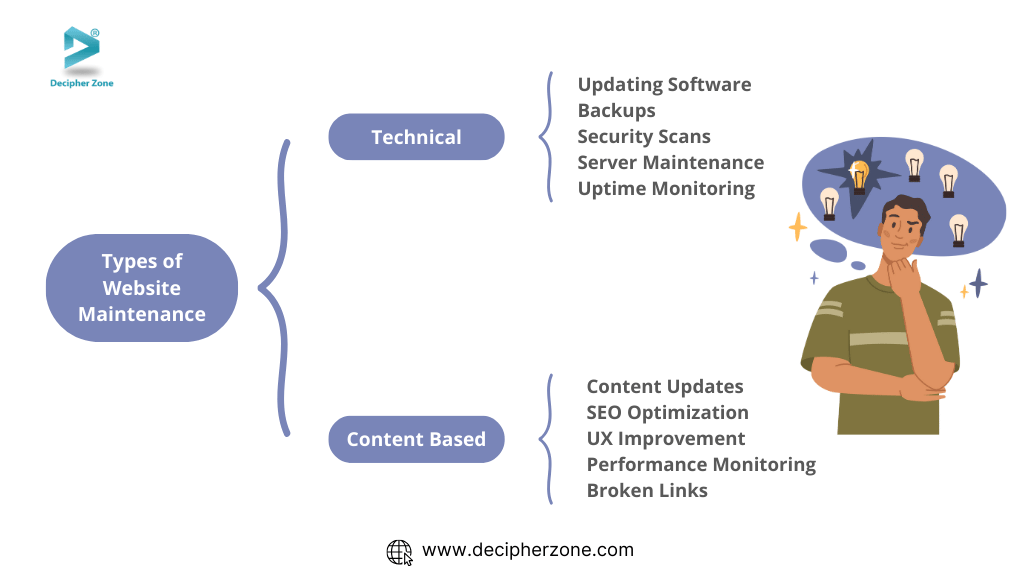Website maintenance encompasses a wide range of tasks that go beyond just analyzing performance. In this blog, we will cover everything from definition to benefits, types of maintenance, common mistakes businesses make, suggested solutions, involved costs, and answers to frequently asked questions.
Developing a website to build your business’s online presence is essential in the digitalized era we live in. But that’s only half the battle conquered. The other half depends on the regular maintenance of your website.
A Complete Website Maintenance Guide
Maintaining the website is often the last thing on the to-do list of any business as other tasks become a priority. Running a website isn't easy; you have to be responsible for updates that improve the user experience. This blog explains all the ins and outs of website maintenance that will help you make the website interface seamless and the user experience adequate.
What you will learn:
-
What is website maintenance?
-
What does website maintenance involve?
-
What are the key components of website maintenance?
-
Why is web maintenance important for business?
-
What are the types of website maintenance?
-
What are some common problems and their solutions regarding website maintenance?
-
How much does it cost to maintain a website?
Defining Website Maintenance
Website maintenance is like giving a little TLC (Tender Loving Code) to your digital home. It is an ongoing process of keeping the website up-to-date and in tip-top shape - kind of sweeping away virtual cobwebs or tidying up forgotten corners of the room.
Websites are not just pretty interfaces made up of pixels, they are there for a purpose like selling products, offering services, or sharing information. Regular maintenance of the website ensures that the website stays relevant to the latest trends, performs well, remains secure, and meets changing user and security requirements.
What does Website Maintenance Involve?
Some of the important aspects of website maintenance are as follows:

1. Link Patrol
Have you ever clicked on a link that ended up in some sort of page not found error? Yeah, those are the broken links that need to be regularly checked and fixed.
2. Security
Installing security measures on a website can help to address security vulnerabilities and prevent cyber attacks, as well as the installation of malware, that could exploit sensitive data.
3. Content Spruce-Up
Adding new content, freshening up the existing one, and eliminating outdated information, making the website content fresh and boosting user engagement.
4. Plugin & Theme Updates
Plugins and themes are like fashionable accessories for your website, keeping it functional and elegant. It's essential to regularly check for outdated plug-ins and update them to ensure compatibility and security.
5. Performance Monitoring
Use tools that help monitor how the website is performing and point out any flaws and errors. This proactive approach allows for immediate fixes, which can help prevent an increase in the website's bounce rate.
6. SEO
Search engines like Google and Bing adores fresh and well-written content on the website. Working on the meta tags, keywords, content titles, headings, and subheadings can do wonders for the website rank.
7. Functionality Check
Another crucial aspect of website maintenance is none other than its functionality check. To ensure that the website is working efficiently across browsers and devices, test the responsiveness of buttons, forms, and other interactive elements.
8. Backup
No website can stay secure indefinitely. At some point, it's likely to encounter problems that could result in data loss. However, regular backups can serve as a safety net in case things go wrong, helping prevent such situations.
9. SSL Certificates
Secure Socket Layers (SSL) certificates are vital to keep the website and its data protected from cyber attacks. SSL also builds trust among users who only visit secure sites. It also prevents browsers from sending potential threat warnings before allowing users to browse the site without SSL certification.
10. Hosting
Monitoring the hosting providers' outages, such as uptime, alerts, and resource usage, and keeping track of expiration dates and plans to renew hosting plans will help ensure that your website runs smoothly without any hiccups.
Why Website Maintenance for Businesses is Necessary?
Although a few benefits of website maintenance were discussed above, let’s learn some more reasons why you should invest some time and effort in website maintenance.

1. Better Website Performance
One of the main advantages of maintaining the website regularly is website performance improvement. Regular code, script, plugins, and feature updates keep everything running smoothly, minimizing the chances of rusty gears in the website.
2. Security Improvements
With the ever-increasing cyber threats through malware, phishing, deceptive redirections, and social engineering for data theft. Security patches in the website maintenance process reinforce the weak spots in the website, keeping hackers away and user data safe.
3. Cost Savings
With preventive maintenance, it becomes easier to catch any errors and vulnerabilities at an early stage, saving the business from major repairs down the lane that cost a fortune. In short, small fixes in website maintenance can save a ton of money for the business.
4. Reliability
Your website builds brand loyalty and trust among the users. Regular maintenance helps ensure that there are no broken links, slow page loads, feature unavailability, etc., leading to better reliability.
5. Analytics and Performance Monitoring
Integrating monitoring tools into the website helps you gain a sneak peek at the conversion rates, bounce rates, and key metrics. Monitoring helps understand user problems, allowing developers to work on the weak points of the website and fine-tune it for better user interactions.
6. Better SEO
As mentioned earlier in the blog, search engine loves a website that focuses on user engagement rather than search engine page ranking. That’s why continuously updating the existing content, optimizing visual elements, uploading fresh content, and faster load times make search engines swoon over the website.
Types of Website Maintenance
With a better understanding of what website maintenance is and what it involves, let’s take a step ahead to the types of preventive maintenance that can be done.
Technical Maintenance
It involves a variety of technical tasks that ensure that the website is working as expected and is secure.
-
Software Updated: Continuous software (like CMS, Plugins, and APIs) updates in the website to fix bugs, security issues, and performance errors.
-
Backups: Regularly backing up the data collected from the user interactions on the website can help in the case of accidental changes, data loss, and cyber attacks.
-
Security Scans: Running security checks to detect vulnerabilities and addressing them efficiently can protect the website from potential hacking and threats.
-
Server Maintenance: Making sure that the hosting server is maintained, secure, and optimized prevents downtime, protects data and the system, extends server lifespan, and prevents security breaches.
-
Uptime Monitoring: Keeping track of the website's uptime through monitoring tools can help investigate the issues and resolve them immediately.

Content-Based Maintenance
It is much more than just keeping the content updated and relevant, it involves resolving broken links, improving user experience, SEO optimization, and performance monitoring.
-
Content Updates: Reviewing existing content and updating it based on current trends and changes can improve the user experience and website credibility.
-
SEO Optimization: Regularly optimizing the website content such as meta tags, keywords, and blogs along with page load speed optimization can yield exceptional SEO outcomes.
-
UX Improvement: Examining and improving the navigation, design, and readability of the website will improve the user experience leading to better engagement and lower bounce rates.
-
Performance Monitoring: Monitoring the page load speeds, site performance, and virtual element sizes and optimizing when needed is vital for smooth user interactions.
-
Broken Links: Evaluating broken internal and external links and fixing them to avoid frustrated users and lower SEO page ranks.
Website Maintenance: Common Mistakes & Solutions
Below are the common mistakes that businesses most likely make when it comes to maintaining the website and how to fix them.
Mistake 1: Neglecting Regular Updates
The Issue: Most often business treats their website like a faded photograph in a weathered album - never opening it. This when done with websites leads to outdated content, poor performance, and a ton of vulnerabilities.
Solution: To overcome this issue you need to keep track of the website. Only then you will be able to refresh the content, keep the software and plugin updated, and apply security patches to protect against weaknesses.
Mistake 2: Relying on Hosting Providers for Backups
The Issue: Businesses are more likely to assume that the hosting providers will back up their websites automatically without thinking about the consequences of data corruption or server crashes.
Solution: To avoid committing the same mistake and facing the aftermath, you will have to take control of the backups and set up regular backups (daily, weekly, or monthly) using reliable services and test restoring the data to guarantee the backup is working.
Mistake 3: Trying to do everything by yourself
The Issue: Being enthusiastic about trying new things is great but when it comes to maintaining the website, you will have to let the professional do the work until or unless you have the required skills - UI designing, development, security implementation, and more.
Solution: If you don’t have the required skills to maintain the website, outsource professionals who are experts in doing so. It will help take your mind off things you don’t have expertise in and focus on important tasks - running your business.
Cost of Website Maintenance
The average cost of maintaining a website ranges from $800 to $70,000 per year. Some of the major expenses associated with maintenance are SSL certificates, web hosting renewals, domain name renewals, business email service renewals, tech support, hiring professional developers for updates & redesigning, and web plugins. The exact cost of the maintenance depends on website requirements and types.
Final Thoughts
Maintaining a website is not just about ticking a task off the to-do list; it’s more like running a well-oiled machine that requires regular upgrades and tuning. The reason why we are saying that website maintenance is crucial for your business’s digital success is, that it can help improve the UI navigation, brand reputation, cybersecurity, SEO, and performance through the different steps and methods stated above.
Now about website development: it’s like crafting a beautiful storefront in the digital world. If you’re ready to connect with professionals who will handle design, development, and ongoing maintenance, just like a skilled mechanic who tends to the machine and keeps it running. Feel free to share your business requirements with our experts and book your free consultation today!
FAQs
1. How often is website maintenance required?
Make sure to schedule regular website maintenance at least once a month to keep your site error-free and running smoothly. It's even better to perform maintenance more frequently if possible. Don't forget to check for and fix broken links, enhance security measures, and keep your content up to date. Your website's success depends on it.
2. Should I hire a professional or maintain a website on my own?
Hiring a professional or maintaining the website on your own depends on different factors like website complexity, technical expertise, time, availability, and budget. If you are not familiar with the tech stack required to maintain the website, it is best to leave the work to the professionals. It will not only save time but also identify and resolve complex issues faster than you could.
3. What is the process of website maintenance?
Website maintenance is not a one-size-fits-all process and depends entirely on the specific issues the website is experiencing. These issues can be related to outdated plugins, software, tools, content, security vulnerabilities, or performance errors. You have to look into the difficulties your website is facing and resolve them accordingly.

